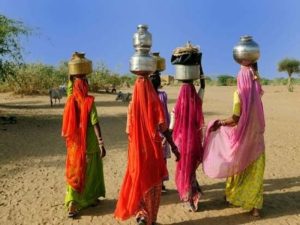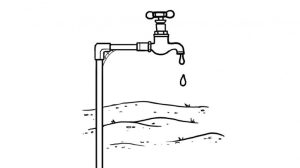As many as 256 of 700 districts reported critical or over-exploited groundwater levels as of 2017.
 Photo courtesy: RCH/Fotolia
Photo courtesy: RCH/Fotolia
Fetching water in India has been perceived as a woman’s job for centuries, especially in rural areas. As groundwater resources come under increasing pressure due to over-reliance and unsustainable consumption, wells, ponds and tanks dry up. This has escalated the water crisis and placed an even greater burden on accessing water on women.
Several girls are denied education purely because they are entrusted with it.
India constitutes 16 per cent of the world’s population, but the country has only four per cent of the world’s freshwater resources. With the changing weather patterns and recurring droughts, India is water-stressed.
As many as 256 of 700 districts have reported ‘critical’ or ‘over-exploited’ groundwater levels, according to the latest data from the Central Ground Water Board (2017). This means that fetching water in these districts has become harder as the water table has fallen.
A rural woman in Rajasthan walks over 2.5 kilometres to reach a water source, according to a report by the National Commission for Women. This is probably an underestimation, but the bottom line is that our women and girls spend a significant proportion of their time fetching water.
India has been consistently working towards improving access to water. The Jal Jeevan Mission (JJM) guidelines released in 2019 provide provision of tap water connections to households, which holds promise for the women in the country.
If implemented to the last mile, women and girls will not have to go through the arduous job of fetching water. JJM stresses the need to involve women in leading the scheme’s activities, especially at the village level.
 Photo courtesy: Pragati Staff
Photo courtesy: Pragati Staff
Women are required to constitute 50 per cent of the village water and sanitation committees in villages. The ‘Swajal’ programme under JJM comprises a women’s development initiative, designed to upskill them, improve their income-earning capabilities, and connect them to the market with help from support organisations.
However, habitations with less than 25 per cent of its population with access to safe drinking water were granted lower priority in coverage. This indicates that water-stressed regions continue to suffer, and so do women and girls.
Though water, sanitation and hygiene (WASH) policies are gender-sensitive in their design and planning, they fail to measure the gendered impact of the policy. Most evidence available is anecdotal, and there is no quantitative data or monitoring to substantiate how the policy stands to bridge the gender gap.
Policies must employ gender analysis tools to develop a framework for such measurement and integrate it with the management information system or mobile apps to track progress on gendered outcomes. To create an ecosystem for gender transformation, it is crucial for WASH policies to go beyond gender sensitivity and address gender inequality.
Even with all of the challenges, several communities are currently implementing more equitable and inclusive community-led total sanitation (CLTS) and WASH programmes through the Gram Panchayat Water Sanitation Committees, designed to provide adequate, accessible and sustainable solutions for those in need.
Involving women in designing, planning and implementing WASH programmes will socially include them and ensure gender equality, which will help them in decision-making: To deal with school dropouts, and improve literacy and health outcomes.
Our world is packed with knowledge, innovation and capacity, and our journey to achieve goal six of the United Nations-mandated Sustainable Development Goals could just become easier if we remain engaged, influential, and productive to ensure the availability and sustainable management of water and sanitation for all by 2030.
Neerain is proud to republish this article for spreading awareness about situation of water, for our stakeholders. Credit whatsoever goes to the Author.
https://www.downtoearth.org.in/blog/water/india-s-water-crisis-the-seen-and-unseen-76049–
This article is published by: –
We would like to spread this for the benefit of fellow Indians.
Author: Mahesh Nathan
Publish On: Friday 19 March 2021
